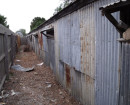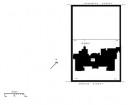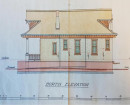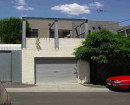Back to search results
SAMBAS GOLD MINE
GREAT ALPINE ROAD HARRIETVILLE, ALPINE SHIRE
SAMBAS GOLD MINE
GREAT ALPINE ROAD HARRIETVILLE, ALPINE SHIRE
All information on this page is maintained by Heritage Victoria.
Click below for their website and contact details.
Victorian Heritage Register
-
Add to tour
You must log in to do that.
-
Share
-
Shortlist place
You must log in to do that.
- Download report

Diagram 2356


On this page:
Statement of Significance
What is significant?
The Sambas Gold Mine including abandoned and working mining infrastructure and archaeological remains. Above ground infrastructure includes a battery shed and gold retrieval plant, and a stamping battery. Mining workings in the landscape include eleven adit levels (horizontal tunnels) and earthworks such as mullock heaps. Ruinous archaeological features include remnant machinery such as a benched platform, loading ramp, galvanised iron water tank, and parts of a collapsed and partially buried battery.
History Summary
Harrietville is a rural township in north-east Victoria, midway between Bright and Mount Hotham. The first gold was discovered in the area in 1852 and by the late 1850s it became known as the Upper Ovens Goldfield. After the initial phase of alluvial mining in the rivers and creeks, the rich quartz reefs in the surrounding hills were soon discovered. The Sambas reef was struck in 1910 and the lease was taken up by local mining entrepreneur CF Proctor who installed the first stamp battery at the mine. The steep terrain of the Upper Ovens Goldfield meant that the quartz reefs at the Sambas Mine were worked almost exclusively by horizontal tunnels dug into the hillside (referred to as 'adits', a Cornish mining term) rather than the vertical shafts seen in the flatter gold mining landscapes around Bendigo and Ballarat. The Upper Ovens Goldfield was unusual because new and profitable quartz reefs continued to be discovered well into the twentieth century. During the 1950s, the Sambas Mine was by far Victoria's richest small gold mine. The mine is located on Crown Land and has been leased and worked almost continuously since 1910. A bushfire in 2013 damaged the 10-head battery installed in 1966. The battery was restored and mining continues to the present time at the No. 11 adit.
Description Summary
The Sambas Gold Mine is a a historically layered landscape of abandoned and working mining infrastructure formed over several decades. The mine elements include a battery shed and gold retrieval plant, comprising a stamping battery (manufactured by Thompson & Co. Castlemaine), three Butchart shaking tables and a floatation system. There is also an ore crushing plant including a fine ore bin, rod mill, disused rod mill, secondary crusher, primary crusher and air compressor tanks. Mining workings in the landscape include eleven adit levels, earthworks such as mullock heaps, tailings dumps and embankments. Ruinous archaeological features and remnant machinery includes a benched platform, loading ramp, galvinsed iron water tank and battery, known as the No.7 battery, which is partially buried. The extent is 3.17 hectares, the landscape is mountainous and the estimated terrain elevation is approximately 840 metres above sea level.
This place is on the traditional land of Waveroo. There is no Registered Aboriginal Party for this place.
How is it significant?
The Sambas Gold Mine is of historical and archaeological significance to the State of Victoria. It satisfies the following criterion for inclusion in the Victorian Heritage Register:
Criterion A
Importance to the course, or pattern, of Victoria's cultural history.
Criterion B
Possession of uncommon, rare or endangered aspects of Victoria's cultural history.
Criterion C
Potential to yield information that will contribute to an understanding of Victoria's cultural history.
Criterion D
Importance in demonstrating the principal characteristics of a class of cultural places and objects.
Why is it significant?
Sambas Gold Mine is significant at the State level for the following reasons:
The Sambas Gold Mine is historically significant because of it is association with gold mining in Victoria and the particular adit mining techniques evident in the Upper Ovens Goldfield and other mountainous areas of Victoria. This relatively intact palimpsest of mine workings is a rare example of a once widespread form of small scale adit gold mining carried out in the mountainous regions of the state. It now is the oldest working mine of its type in Victoria.
(Criterion A)
The Sambas Gold Mine is significant as a rare landscape of abandoned and working mining infrastructure which has formed over several decades relating to the particular practice of adit mining. It contains an uncommon assemblage of ore crushing machinery and gold retrieval technology, both redundant and in-use, that survives at the site including the stamping battery and rod mills
(Criterion B)
The Sambas Gold Mine is of archaeological significance for its likelihood to contain archaeological remains that relate to the construction and use of adit gold mines in Victoria. It has the potential to yield artefacts and evidence which will provide information about the cultural and technological history of adit gold mining, and the miners involved in this practice over the last hundred years
(Criterion C)
The Sambas Gold Mine is significant as the most representative, intact and continuing adit mine in Victoria. It is notable for its wide range of crushing and processing technology on display, such as a working stamp battery and rod mills. All elements of the mine are located in close proximity to each other on a small site allowing an understanding of the operations of a small adit mine, and the significance of the place to be readily observed and interpreted. The site demonstrates the practice of adaptive reuse of fabric over time, such as after the 2013 bushfire, and the practice of integrating mining machinery from other locations.
(Criterion D)
Sambas Gold Mine is also significant for the following reasons, but not at the State level:
(Criterion D)
Sambas Gold Mine is also significant for the following reasons, but not at the State level:
The Sambas Gold Mine is socially important as one of the most productive gold mines in the history of the Upper Ovens Goldfield region. It was one the most important reef mine employers for Harrietville and Alpine Shire residents from the 1930s to the early 1970s. It is an intermittent employer of miners to the present day forging strong connections within and across generations of Harrietville families.
(Criterion D)
Show more
Show less
-
-
SAMBAS GOLD MINE - History
HISTORY
[The following text has been drawn from Rob Kaufman Cultural Heritage Report: Remedial Works Sambas No. 7 Battery, LRGM Services, August 2013.]The Sambas Gold Mine is an operating mine whose history and fabric goes back to the early 1900s. The mine is located in the Upper Ovens goldfield and is the part of the living echo of the Victorian gold rush. Mining in the area began in 1853-54 with miners getting gold nuggets (alluvial gold) from the stream systems. By 1858, the source of the gold, the quartz reefs, in the ranges above the streams were being mined. The Upper Ovens goldfield was unusual in that new and profitable quartz reefs continued to be discovered well into the twentieth century.The Sambas Reef was discovered by Tom Powers of Harrietville in 1910. He took out a six-acre lease and named the mine the ‘Sambas’ after the town of the same name in east Borneo. Some rich crushings were taken out by Powers until 1917 when the reef was lost on a fault. Local mining entrepreneur CF Proctor took up the lease in the late 192Os. He installed the first stamp battery at the mine, just below the 7-level adit on the Hotham Road (Great Alpine Road) and worked from the 7 and 8-level adits. He gradually increased annual production till his death in 1947, when the mine ownership passed to his widow.Charles Tavare was then appointed manager of the Sambas mine. Operations were improved in 1950 with the purchase of an air compressor and pneumatic drills. Norm Staff assumed management of the mine after marrying Lillian Proctor in 1952, and a new battery was installed at the level-9 adit in 1954. Gold production peaked in the mid-1950s at over 2000 ounces per year under the management of Neville Wolff, working from the 1-level adit from 1955 (level-10 was Tunnel B of the former English Company on the Tiddle-de-addle-de Reef). Some was crushed at the Lady Jane battery in a gully to the north of No 10 adit.During the 1950s, it was by far Victoria's richest small gold mine. The steep terrain meant that the quartz reefs at the Sambas Mine were worked almost exclusively by tunnels, rather than shafts. It is more economical and easier to drive a tunnel (normally referred to as adits, a Cornish mining term) into a hillside, than sink a shaft downwards from the top of a hill. When the gold content available from one adit was exhausted, another one, either 100 metres above or below, was opened up. (See diagram 1 for illustration of adit mining)High production continued until the mid-1960s with up to twenty-three men employed at the mine. After Wolff left in 1966, Norm Staff purchased a 10-head battery from the Williams United Mine at Wandiligong and installed it at the 10-level, eliminating costly ore transport to the Lady Jane. Production declined in the late 1960s and operations ceased in 1971. A year later the mine was taken over on tribute by Les Lawson and Archie Wilson and obtained small but profitable crushings into the 1980s.Total production to 1981 was about 44,000 ounces of gold and exceeded 50,000 ounces by 2012. This makes the Sambas Gold Mine the third highest producing reef mine in the history of the Upper Ovens Goldfield, behind the Rose, Thistle and Shamrock Mine at Harrietville and the Oriental Mine at Wandiligong.In recent times the lease has been owned by a succession of companies and a significant number of people has been employed at the mine intermittently. New plants include a large carbon-in-pulp cyaniding works, and a rod mill. One recent lease holder was Hazav Pty Ltd, which worked from the ten-level adit on a commercial basis under the management of Simon Law. A flotation plant was installed at this time and driving works commenced of the 11-level (Adit A of the former English Company on the Tiddle-de-addle-de Reef). The mine is now (2016) operated under the managership of Mitch Kermond. He refurbished the mine after Black Saturday (2013 bushfire), including re-building the battery shed with the original corrugated iron roofing in its original location. Its refurbishment demonstrates the technical ingenuity and self-reliance of miners which is a hallmark of this type of mining.SAMBAS GOLD MINE - Plaque Citation
The Sambas Gold Mine (1910) is a rare example of an intact adit mine which were once widespread in the mountainous goldfield regions of Victoria. It contains an assemblage of technology such as a working stamp battery and rod mills.
SAMBAS GOLD MINE - Permit Exemptions
General Exemptions:General exemptions apply to all places and objects included in the Victorian Heritage Register (VHR). General exemptions have been designed to allow everyday activities, maintenance and changes to your property, which don’t harm its cultural heritage significance, to proceed without the need to obtain approvals under the Heritage Act 2017.Places of worship: In some circumstances, you can alter a place of worship to accommodate religious practices without a permit, but you must notify the Executive Director of Heritage Victoria before you start the works or activities at least 20 business days before the works or activities are to commence.Subdivision/consolidation: Permit exemptions exist for some subdivisions and consolidations. If the subdivision or consolidation is in accordance with a planning permit granted under Part 4 of the Planning and Environment Act 1987 and the application for the planning permit was referred to the Executive Director of Heritage Victoria as a determining referral authority, a permit is not required.Specific exemptions may also apply to your registered place or object. If applicable, these are listed below. Specific exemptions are tailored to the conservation and management needs of an individual registered place or object and set out works and activities that are exempt from the requirements of a permit. Specific exemptions prevail if they conflict with general exemptions. Find out more about heritage permit exemptions here.
-
-
-
-
-
SAMBAS GOLD MINE
 Victorian Heritage Register H2356
Victorian Heritage Register H2356 -
SAMBAS NO.7 BATTERY
 Victorian Heritage Inventory
Victorian Heritage Inventory
-
'NORWAY'
 Boroondara City
Boroondara City -
1 Mitchell Street
 Yarra City
Yarra City
-
-










